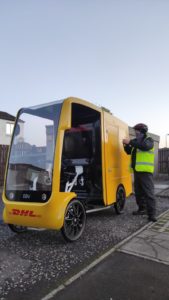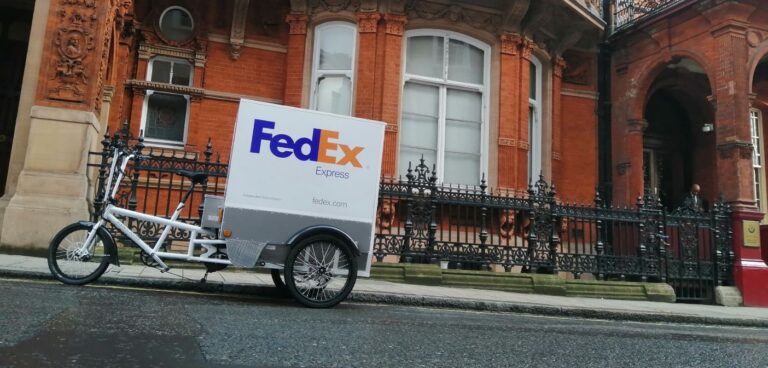As part of a wider shift to a sustainable supply chain, many logistics companies are turning to cargo bikes. But Maria Highland asks – do they really deliver?…
One can argue that vans are prone to congestion and e-bikes can’t carry enough. Naturally, this would pave the way for cargo-bikes as a happy medium. But their application is not as widespread as we would hope, albeit promising for last-mile.
A 2021 study funded by Possible, The Promise of Low-Carbon Freight: Benefits of cargo bikes in London, found that in the UK capital cargo bikes delivered parcels around 60% faster compared to vans – averaging a higher speed and delivering almost twice as many parcels an hour. The study highlighted that cargo bikes cut emissions by 90% compared with diesel vans and 33% compared with electric vans – which would result in 14,500kg of CO2 and more than 20kg of NOx being saved a year.
The study noted that “goods vehicles contribute to deteriorating public space quality, air quality, and other road users’ safety”, suggesting that “cargo bikes, having become popular in several cities, can provide an alternative to the current damaging freight transport model which is increasingly relying on delivery vans”.
Pretty much anything you can think of today can most likely get delivered. Although for the consumer this is a boon, it has the potential to be a serious issue for cities where congestion and pollution are persistent issues. “The rise of quick commerce is faster and more aggressive than we could have imagined,” suggests Lisa Conibear, UK & EU regional director of Zoomo. “The skyrocketing demand for deliveries can create transport problems in our cities, be it greenhouse gas emissions, traffic congestion, accidents and even noise pollution.”
Bike benefits
It’s not all doom and gloom however. “These challenges present a huge opportunity for businesses and governments to rethink the mode of transport needed to move goods around our cities,” she adds. “We need to consider not only the type of engine used but also whether it is practical to use a two-tonne vehicle to transport a few burgers through the city streets.
“Motorised light electric vehicles, such as e-bikes, e-mopeds and e-cargo bikes, are emerging as the solution,” Conibear adds. “And when combined with the right safety features for riders, they can solve some of the big issues with last-mile delivery.”
Edward Clarke, vice president of operations at FedEx Express, considers cargo bikes as having great potential for parcel pick-up and delivery, particularly in European cities where infrastructure and culture make cycling a viable alternative to motorised vehicle such as vans. “In some cases, they are directly replacing a motorised vehicle for certain pick-up or delivery routes,” he reveals.
“As well as having an immediate impact on emissions, the advantages of cargo bikes are many,” Clarke adds. For example, “serving certain routes with cargo bikes in place of diesel vehicles helps reduce congestion and allows couriers to make use of existing cycle or bus lanes, etc, where permitted. In some cases, a bike also allows better access to the pick-up or delivery location, minimising stop time and making finding curb side space easier than in a van.”
Likewise, Clarke points out that “research has also revealed a particularly interesting ‘side effect’ of increased cycling and cycling infrastructure on road safety, citing that an increase in cycling overall generates a safer road transport system, improving road safety for all road users, regardless of vehicle choice”.
Natalie Frow is vice president operations – home delivery at DHL Supply Chain, and believes cargo bikes “can form part of a more flexible and mixed fleet with lower maintenance and operating costs, while speeding-up deliveries as traffic congestion becomes less of an issue”. Alongside this, she adds, “driver recruitment can become more inclusive due to reduced or no licence requirements and we’re likely to see significant improvement in rider health and well-being”.

Finding a way
There are limitations that should be taken into consideration before implementing them widely though – such as weather, safety and available infrastructure. “Adverse winter weather conditions can limit the opportunities for bikes to be used as well as their appeal to riders,” says Frow. “Road safety is another factor here,” she adds, noting that congested roads, poor visibility, dark nights and a lack of car-free cycle paths must be considered when thinking about implementing cargo-bikes.
“Another challenge is the lack of suitable infrastructure and charging systems, with electric cargo bikes currently restricted to inner-city locations until battery technology and lifetime improves,” Frow continues. Likewise, “decision-makers need to consider the space on the bike, the types of products being carried, and the locations they’re delivering to, before deciding whether cargo bikes are the most efficient option, with their required multiple reloads at depots or urban meeting points”.
Luckily, such issues can be worked around. “Certain routes are ‘prime’ for a transition from van to cargo bike, while in other cases, our routing and operations can be reworked so multiple bikes are working alongside an EV which is then transporting packages into and outside the urban centre,” believes FedEx’s Clarke. “This maximises the battery life and efficiency of the EV and bikes by careful route optimisation that minimises the miles travelled.”
In theory, e-cargo bikes are promising, and many companies appear to be getting behind the novel solution, such as DHL, Ford, UPS, FedEx, Hermes, and so on, showing that e-cargo bikes have good real-world applications, too. “E-cargo bikes are becoming a vital part of our pick-up and delivery fleet as we strive to make zero-emissions deliveries our standard,” Clarke says. “FedEx Express pilots in several European cities made the case for introducing cargo bikes in a considered roll-out: we have already introduced small numbers to operations In London, Cambridge, Glasgow and Edinburgh, as well as cities in Spain, the Netherlands and France.
FedEx intends to “continue to evaluate opportunities to introduce e-cargo bikes as alternative to motorised or even electric vehicles, to ensure we are ready to support the sustainability needs and ambitions of European cities and global governments”, notes Clarke. DHL is also seeing good results. “We’re delivering tangible results for our customers,” suggests Frow, “most recently on our trial around Livingston and Edinburgh, where we’re making seven to eight drops a day, each carrying around four items at a time, including mattresses and home furnishings”.
This trial began in November 2021 and uses a cargo bike manufactured by EAV, which has a load capacity of 2m3 and a range of around 40 miles on a single charge. It is reliable, easy, and has low operational costs, making it ideal for urban areas. Frow concludes: “The eCargo bike has the potential to transform the way we make many home deliveries, not just in the urban environment but across the country, so we’re looking forward to seeing the trial results.”
Sustainable scooter delivery
Ford’s micromobility unit Spin conducted two cargo bike trials at the end of 2021. Taking place in Colchester and Chelmsford, they ran for three months and focused on providing greener logistics to distribute, replace and recharge drained e-scooter batteries.The trial aimed to reduce the number of vans on the road and help ease congestion in the local area. “E-cargo bikes have the potential to deliver faster, cut congestion and improve road safety in urban areas when compared to vans,” suggests Steve Pyer, Spin UK country manager. “That’s why we have integrated e-cargo bikes into our daily operations.”
In Chelmsford, Spin deployed the EAV 2Charge e-cargo bike to help ease traffic and support cleaner air.
E-scooters: out of the question?
For Zoomo, e-scooters are not the most practical choice for logistics. “E-bikes just make more sense as an efficient form factor for last-mile delivery,” says the company’s Lisa Conibear.
They require less maintenance, have heavier carrying capacities and are overall safer, Conibear adds. For example, e-bikes have “integrated lights for night-time deliveries and thicker, more durable tyres for any weather condition. They also adhere to faster speed limits and are allowed to zip around bike lanes, unlike e-scooters which are legally not allowed in these lanes in the UK”. Likewise, not all cities have laws or infrastructure ready to safely support a surge in e-scooters.
FedEx, however, hasn’t entirely ruled e-scooters out. According to the company’s Edward Clarke, it “will continue to evaluate the circumstances where they may present an ideal solution… these could be attractive for pick-up and delivery in certain warmer climates or hilly cities where additional power is required to help with inclines”.
This article was originally published in the March 2022 issue of CiTTi. Click here to view the original article.





